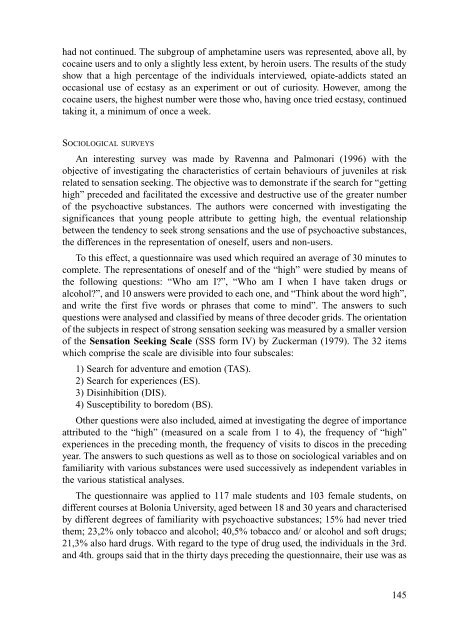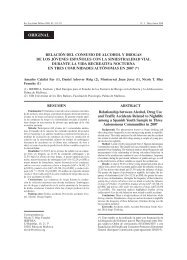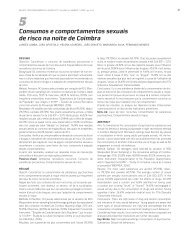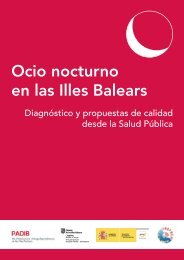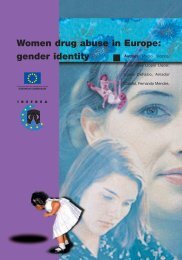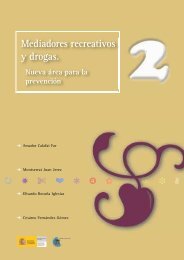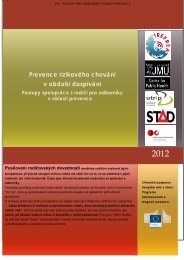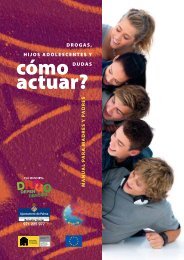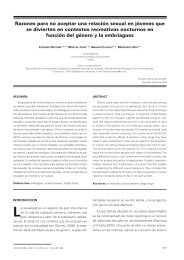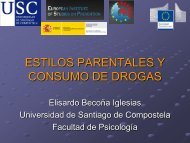Characteristics and social representation of ecstasy in Europe - Irefrea
Characteristics and social representation of ecstasy in Europe - Irefrea
Characteristics and social representation of ecstasy in Europe - Irefrea
You also want an ePaper? Increase the reach of your titles
YUMPU automatically turns print PDFs into web optimized ePapers that Google loves.
had not cont<strong>in</strong>ued. The subgroup <strong>of</strong> amphetam<strong>in</strong>e users was represented, above all, bycoca<strong>in</strong>e users <strong>and</strong> to only a slightly less extent, by hero<strong>in</strong> users. The results <strong>of</strong> the studyshow that a high percentage <strong>of</strong> the <strong>in</strong>dividuals <strong>in</strong>terviewed, opiate-addicts stated anoccasional use <strong>of</strong> <strong>ecstasy</strong> as an experiment or out <strong>of</strong> curiosity. However, among thecoca<strong>in</strong>e users, the highest number were those who, hav<strong>in</strong>g once tried <strong>ecstasy</strong>, cont<strong>in</strong>uedtak<strong>in</strong>g it, a m<strong>in</strong>imum <strong>of</strong> once a week.SOCIOLOGICAL SURVEYSAn <strong>in</strong>terest<strong>in</strong>g survey was made by Ravenna <strong>and</strong> Palmonari (1996) with theobjective <strong>of</strong> <strong>in</strong>vestigat<strong>in</strong>g the characteristics <strong>of</strong> certa<strong>in</strong> behaviours <strong>of</strong> juveniles at riskrelated to sensation seek<strong>in</strong>g. The objective was to demonstrate if the search for “gett<strong>in</strong>ghigh” preceded <strong>and</strong> facilitated the excessive <strong>and</strong> destructive use <strong>of</strong> the greater number<strong>of</strong> the psychoactive substances. The authors were concerned with <strong>in</strong>vestigat<strong>in</strong>g thesignificances that young people attribute to gett<strong>in</strong>g high, the eventual relationshipbetween the tendency to seek strong sensations <strong>and</strong> the use <strong>of</strong> psychoactive substances,the differences <strong>in</strong> the <strong>representation</strong> <strong>of</strong> oneself, users <strong>and</strong> non-users.To this effect, a questionnaire was used which required an average <strong>of</strong> 30 m<strong>in</strong>utes tocomplete. The <strong>representation</strong>s <strong>of</strong> oneself <strong>and</strong> <strong>of</strong> the “high” were studied by means <strong>of</strong>the follow<strong>in</strong>g questions: “Who am I?”, “Who am I when I have taken drugs oralcohol?”, <strong>and</strong> 10 answers were provided to each one, <strong>and</strong> “Th<strong>in</strong>k about the word high”,<strong>and</strong> write the first five words or phrases that come to m<strong>in</strong>d”. The answers to suchquestions were analysed <strong>and</strong> classified by means <strong>of</strong> three decoder grids. The orientation<strong>of</strong> the subjects <strong>in</strong> respect <strong>of</strong> strong sensation seek<strong>in</strong>g was measured by a smaller version<strong>of</strong> the Sensation Seek<strong>in</strong>g Scale (SSS form IV) by Zuckerman (1979). The 32 itemswhich comprise the scale are divisible <strong>in</strong>to four subscales:1) Search for adventure <strong>and</strong> emotion (TAS).2) Search for experiences (ES).3) Dis<strong>in</strong>hibition (DIS).4) Susceptibility to boredom (BS).Other questions were also <strong>in</strong>cluded, aimed at <strong>in</strong>vestigat<strong>in</strong>g the degree <strong>of</strong> importanceattributed to the “high” (measured on a scale from 1 to 4), the frequency <strong>of</strong> “high”experiences <strong>in</strong> the preced<strong>in</strong>g month, the frequency <strong>of</strong> visits to discos <strong>in</strong> the preced<strong>in</strong>gyear. The answers to such questions as well as to those on sociological variables <strong>and</strong> onfamiliarity with various substances were used successively as <strong>in</strong>dependent variables <strong>in</strong>the various statistical analyses.The questionnaire was applied to 117 male students <strong>and</strong> 103 female students, ondifferent courses at Bolonia University, aged between 18 <strong>and</strong> 30 years <strong>and</strong> characterisedby different degrees <strong>of</strong> familiarity with psychoactive substances; 15% had never triedthem; 23,2% only tobacco <strong>and</strong> alcohol; 40,5% tobacco <strong>and</strong>/ or alcohol <strong>and</strong> s<strong>of</strong>t drugs;21,3% also hard drugs. With regard to the type <strong>of</strong> drug used, the <strong>in</strong>dividuals <strong>in</strong> the 3rd.<strong>and</strong> 4th. groups said that <strong>in</strong> the thirty days preced<strong>in</strong>g the questionnaire, their use was as145


